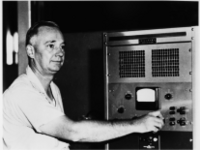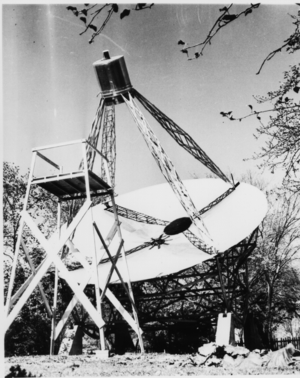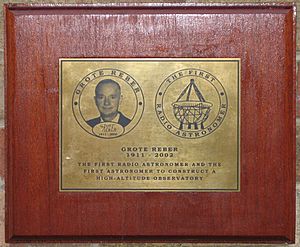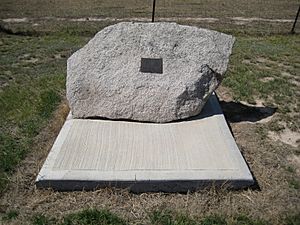Grote Reber facts for kids
Quick facts for kids
Grote Reber
|
|
|---|---|
 |
|
| Born | December 22, 1911 Wheaton, Illinois, United States
|
| Died | December 20, 2002 (aged 90) |
| Nationality | American |
| Alma mater | Illinois Institute of Technology |
| Known for | Pioneering work in radio astronomy |
| Awards | Elliott Cresson Medal (1963) |
| Scientific career | |
| Fields | Radio astronomy |
Grote Reber (born December 22, 1911 – died December 20, 2002) was an American scientist. He was a pioneer in a field called radio astronomy. This field uses radio waves to study space. Reber loved both amateur radio and amateur astronomy. He built on the important work of Karl Jansky. Reber also created the first map of the sky using radio waves.
In 1937, Reber built a special radio antenna. It was only the second one ever used for astronomy. It was also the first radio telescope shaped like a dish (parabolic). For almost ten years, he was the only person in the world doing radio astronomy!
Contents
Grote Reber's Early Life
Grote Reber was born and grew up in Wheaton, Illinois. This town is a suburb of Chicago. He finished college in 1933. He earned a degree in electrical engineering. The college is now called the Illinois Institute of Technology. Reber was an amateur radio operator. He worked for different radio companies in Chicago. He worked there from 1933 to 1947.
In 1933, he learned about Karl Jansky's work. Jansky had discovered radio waves coming from space. Reber decided this was the field he wanted to work in. He tried to get a job at Bell Labs, where Jansky worked. But it was during the Great Depression. There were no jobs available at that time.
Building His Own Radio Telescope
In the summer of 1937, Reber decided to build his own radio telescope. He built it in his backyard in Wheaton, IL. Reber's telescope was much more advanced than Jansky's. It had a large metal dish, 9 meters (about 30 feet) wide. This dish focused radio waves to a receiver. The receiver was 8 meters (about 26 feet) above the dish.
The whole telescope could tilt. This allowed it to point in different directions. Reber finished building it in September 1937.
First Discoveries in Radio Astronomy
Reber's first receiver tried to pick up signals at 3300 MHz. It did not find any signals from space. His second attempt, at 900 MHz, also failed. Finally, his third try, at 160 MHz, worked in 1938. This confirmed Jansky's earlier discovery.
In 1940, Reber published his first scientific paper. It appeared in the Astrophysical Journal. He was offered a research job. But he turned it down. He wanted to create a map of the sky using radio waves. He finished this map in 1941 and added to it in 1943.
Reber published many important works during this time. He helped start the "explosion" of radio astronomy. This happened right after World War II. His maps showed how bright the sky was in radio wavelengths. They revealed new radio sources. These included Cygnus A and Cassiopeia A. For almost ten years, Reber was the only radio astronomer in the world. After World War II, many scientists joined the field. They had learned a lot about RADAR during the war.
Reber also found a mystery that was not solved until the 1950s. Scientists thought radio waves from space came from hot objects. This is called black-body radiation. If this was true, there should be more high-energy radio waves. But Reber showed the opposite was true. There was a lot of low-energy radio signal. In the 1950s, synchrotron radiation was suggested. This explained Reber's measurements.
Reber later sold his telescope. It was moved to a field station in Sterling, Virginia. Eventually, it ended up at the National Radio Astronomy Observatory. This is in Green Bank, West Virginia. Reber helped rebuild it there. He also helped rebuild Jansky's original telescope.
Exploring Medium Frequency Radio Signals

In 1951, Reber received support from the Research Corporation. He then moved to Hawaii. By the 1950s, many large and expensive instruments were being used. So, Reber decided to study something different. He focused on medium frequency radio signals. These are in the 0.5–3 MHz range. This is similar to AM radio broadcasts.
However, signals below 30 MHz are reflected. They bounce off a layer in Earth's atmosphere. This layer is called the ionosphere. In 1954, Reber moved to Tasmania, Australia. It is the southernmost state of Australia. He worked with Bill Ellis at the University of Tasmania.
In Tasmania, winter nights are very cold and long. The ionosphere would "quieten" and de-ionize. This happened after many hours away from the sun's radiation. This allowed longer radio waves to reach his antenna. Reber called this a "lucky situation." Tasmania also had low levels of man-made radio noise. This helped him receive faint signals from space.
In the 1960s, he set up an array of antennas. It was on a sheep farm called Dennistoun. This was near the town of Bothwell, Tasmania. He lived in a house he designed and built himself. He bought many coach bolts at an auction. He imported large wooden beams from Oregon. He also got special double-glazed windows from the US. The bolts held his house together. The windows faced north. They formed a solar wall. This wall heated black copper sheets. The warm air then rose by convection. The inside walls were lined with reflective aluminum foil. His house was so well insulated that his kitchen oven was almost unusable! The heat from it would raise the room temperature to over 50 °C (120 °F).
Later Life and Legacy
Reber's house was never fully finished. He planned to have a heat storage device. It was meant to be a pit filled with dolerite rocks. But as he got older, his body became weaker. He was never able to move the rocks. He loved mirrors and had at least one in every room.
He had one of the amplifiers from his first telescope. It was probably the one used at 900 MHz. He powered this amplifier, and his later receivers, with batteries. This helped avoid interference from power cables.
Reber did not believe in the Big Bang theory. He thought that red shift was caused by light interacting with dark matter. This happened over long distances in space. In 1977, he published an article. It was called "Endless, Boundless, Stable Universe." This article explained his theory. Reber supported the Tired light idea. This idea explains the redshift-distance relationship.
He spent his final days at the Ouse District Hospital. He died there in 2002. This was two days before his 91st birthday. His ashes are buried at Bothwell Cemetery in Tasmania. They are also placed at many major radio observatories around the world:
- Mount Pleasant Radio Observatory and Grote Reber Museum], Cambridge, Tasmania, Australia
- Parkes Observatory, Parkes, New South Wales, Australia
- Molonglo Observatory, Bungendore, New South Wales, Australia
- Dwingeloo Radio Observatory, Netherlands
- Jodrell Bank, Cheshire, England
- Mullard Radio Astronomy Observatory, Cambridgeshire, England
- Dominion Astrophysical Observatory, British Columbia, Canada
- NASA Goldstone Apple Valley Radio Telescope, California
- United States Naval Observatory, D.C.
- National Radio Astronomy Observatory, Greenbank, West Virginia
- Arecibo Observatory, Puerto Rico
- University of Illinois Radio Telescope, Vermillion County, Illinois
- University of California at Davis
- University of Hawaii, on the summit of Haleakala
- Giant Metrewave Radio Telescope, India
- Tuorla Observatory, Turku, Finland
- Pushchino Radio Astronomy Observatory], Russia
Awards and Recognition
Grote Reber received many awards for his important work:
- Honorary Doctor of Science degree from Ohio State University (1962)
- Bruce Medal of the Astronomical Society of the Pacific (1962)
- Henry Norris Russell Lectureship (1962)
- Elliott Cresson Medal of the Franklin Institute (physics, 1963)
- Jackson-Gwilt Medal of the Royal Astronomical Society (1983)
Reber's Lasting Impact
- An asteroid was named after him: 6886 Grote.
- The Grote Reber Medal was created. It honors his contributions to science.
- The Grote Reber Museum opened in 2008. It is at the Mount Pleasant Radio Observatory.
See also
 In Spanish: Grote Reber para niños
In Spanish: Grote Reber para niños
- John D. Kraus
- Radiophysics




